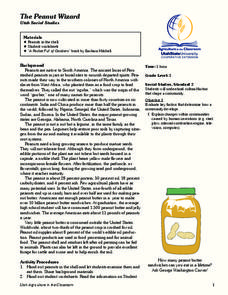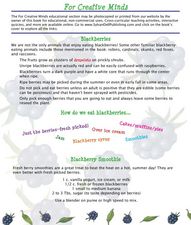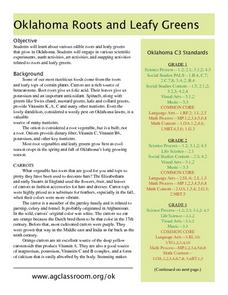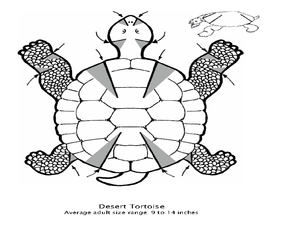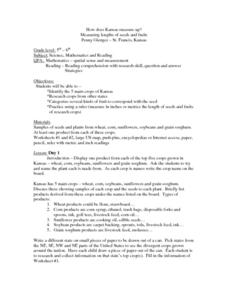Curated OER
Minerals Make Rocks
Students examine that all rocks are made from one or more minerals (or plant material, as in the case of coal). They make mock rocks and discuss the difference between a rock and a mineral.
Curated OER
The Peanut Wizard
Students investigate the history of the peanut. In this social studies lesson, students read the book A Pocket Full of Goobers and examine the a peanut. Students discuss the peanut's characteristics and take notes on an article about...
Curated OER
This Can't be a Plant
Young scholars grow mold. In this science experiment instructional activity, students grow mold on different pieces of bread by adjusting the moisture, temperature, and light. They record the results to see which grows the most mold.
Curated OER
Explorit's Green Salad Quiz
In this food history worksheet, students read the information about the history of food and salads. Students select the correct answer for the 6 related questions.
Curated OER
Yearly Place Based theme
Pupils are awaken to their surroundings. They gain a greater access of how their city was formed. Students assess the human impact on the land. They comprehend the cultural diversity of the city.
Curated OER
JUST A MATTER OF TIME
Students recognize the dynamic changes in themselves and in agriculture that have occurred through the years. They are shown pictures of a baby or students are asked to think of their little brothers or sisters or themselves in...
Curated OER
The Peanut Wizard
Peanuts inspire this lesson plan about George Washington Carver, called The Peanut Wizard in the included informational text. Class members read about peanuts and George Washington Carver and create a timeline of his life. In addition,...
Curated OER
Yummy for my tummy!
First graders read the story Tops and Bottoms and identify vegetables that are eaten from the stem, root, and leaf of a plant. In this vegetables lesson plan, 1st graders learn vocabulary about different vegetable parts and write journal...
Curated OER
Looking Closer at Stems
In this looking closer at stems worksheet, students fill in the blanks. Students use various resources to answer questions about stem morphology and anatomy.
Curated OER
From Flower to Fruit
Young scholars examine how flowers have essentially four parts. They learn both the male and female reproductive parts of the flower, then explore self-pollination and pollination by insects and other animals.
Curated OER
Blackberries
Students read and answer questions about other animals that like blackberries besides humans. In this blackberries lesson plan, students read about what animals like to eat blackberries and what they do for them.
Curated OER
Food Webs
Learners recognize interdependence in a food web by using yarn and notecards to create a food web and discussing what would happen if one of the organisms from a certain trophic level is removed.
Curated OER
Growing Tomatoes From Seed Activity
In this growing tomatoes worksheet, students plant tomato seeds in February, and follow their growth through the summer break. They observe and investigate the plant growth from seed to plant.
Curated OER
Genetic Engineering
Students are introduced to the concept of genetic engineering. In groups, they participate in a variety of experiments, in which they analyze the effect of chemicals on different substances. Using the internet, they research gossypol,...
Curated OER
The Beet Goes On
Root vegetables inspire the series of activities included here. Class members participate in activities related to language arts, social studies, science, visual art, and math. At first, the long list might feel overwhelming; however,...
Curated OER
Diamond Terrapin Fun Facts
In this animal worksheet, students complete 6 pages of activities and exercises pertaining to the diamondback terrapin. Students read about the life cycle, study habitat maps and color and cut out a three dimensional turtle.
Curated OER
How has rice been produced throughout history?
Fourth graders research rice history. In this rice history lesson, 4th graders discover the farming methods used to cultivate rice. They read about the role of rice in many cultures.
Curated OER
Limu in Your Lunch
Students explore various types of algae found in Hawaii. In this science lesson plan, students research species of the three types of limu and identify various uses. Students explore products that contain limu.
Curated OER
Fungus
Students study fungus, its reproduction and uses. In this eukaryote instructional activity students complete several fungal experiments.
Curated OER
There Are Algae in Your House!
Students demonstrate that, although we sometimes can neither smell nor taste them, many ingredients in our foods and household products come from the sea. They also investigate food eat to determine algae derivatives they contain.
Curated OER
LISTENING TO DIRECTIONS
Students view farm objects or products made from farm animals and follow the oral instructions given by the teacher. They are given worksheets, there are three sets of directions for the one worksheet. Students worksheets have everything...
Curated OER
A PRICELESS Collection
Students read a story about the life of Russian plant breeder Nikolai I and Vavilov and the national seed bank he established. They research the Irish Potato Famine of the late 1840s and identify the cause for this famine and make...
Curated OER
A TOUGH NUT TO CRACK
Based on a set of criteria, students will evaluate the quality of pecans.1. Bring a gram scale and papershell pecans. Provide five pecans for each student. 2. Divide the class into groups of five and provide each member with five pecans....
Curated OER
How Does Kansas Measure Up?
Students identify the five main crops of Kansas and crops that are produced in other states. The categorize the types of fruits and seeds of each plant and measure each to compare the length of each.
Other popular searches
- Edible Plants and Flowers
- 8 Edible Plants
- Non Edible Plants
- Edible Plants Worksheet
- Science, Edible Plants
- Family of Edible Plants
- Edible Plants Corn
- Texas Edible Plants
- Edible Plants Survival
- Edible Plants of Texas
- Edible Plants in Alaska
- Forest Edible Plants



